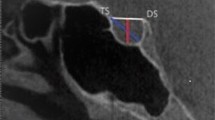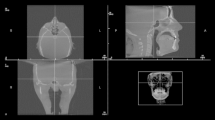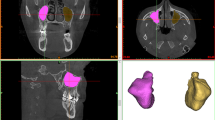Abstract
Purpose
The purpose of this study was to assess the three-dimensional morphometric features of the sella turcica using cone beam computed tomography (CBCT) in subjects with unilateral and bilateral maxillary impacted canines and normal controls.
Methods
In this retrospective study, CBCT images captured with ultra-low dose protocol of 73 subjects (21 males, 52 females; mean age 20.01 ± 6.53 years) with unilateral or bilateral maxillary impacted canines (29 unilateral and 29 bilateral) and 15 controls were evaluated. Nineteen different measurements of the pituitary fossa were made on CBCT images. To evaluate the normality, the Kolmogorov–Smirnov test was used. The nonparametric statistical Kruskal–Wallis and Mann–Whitney U tests were applied to analyze the significant differences among and between the groups. Statistical significance was set at 5%.
Results
No measurement differed significantly among the groups (all p > 0.05) other than the right sella length, which differed between the unilateral and bilateral test groups and the unilateral test group and controls (both p < 0.05). The bilateral test group and control group did not differ significantly, but both exhibited greater right sella length than did the unilateral test group (p > 0.05).
Conclusions
Other than the right sella length, there were no among-group differences in the mean pituitary fossa measurements of subjects with impacted unilateral and bilateral canines and normally erupted canines. The right sella length was lower in subjects with impacted unilateral canines than in those with bilateral impacted canines and normal controls.


Similar content being viewed by others
References
Ali B, Shaikh A, Fida M (2014) Association between sella turcica bridging and palatal canine impaction. Am J Orthod Dentofac Orthop 146(4):437–441
Alkofide EA (2008) Sella turcica morphology and dimensions in cleft subjects. Cleft Palate Craniofac J 45:647–653
Alkofide EA (2007) The shape and size of the sella turcica in skeletal Class I, Class II, and Class III Saudi subjects. Eur J Orthod 29(5):457–463
Andredaki M, Koumantanou A, Dorotheou D, Halazonetis DJ (2007) A cephalometric morphometric study of the sella turcica. Eur J Orthod 29(5):449–456
Axelsson S, Storhaug K, Kjaer I (2004) Post-natal size and morphology of the sella turcica. Longitudinal cephalometric standards for Norwegians between 6 and 21 years of age. Eur J Orthod 26:597–604
Axelsson S, Storhaug K, Kjaer I (2004) Post-natal size and morphology of the sella turcica in Williams syndrome. Eur J Orthod 26:613–621
Baccetti T (1998) A controlled study of associated dental anomalies. Angle Orthod 68:267–274
Baidas LF, Al-Kawari HM, Al-Obaidan Z, Al-Marhoon A, Al-Shahrani S (2018) Association of sella turcica bridging with palatal canine impaction in skeletal Class I and Class II. Clin Cosmet Investig Dent. 20(10):179–187
Becker A, Chaushu S (2015) Etiology of maxillary canine impaction: a review. Am J Orthod Dentofac Orthop 148(4):557–567
Becktor JP, Einersen S, Kjaer I (2000) A sella turcica bridge in subjects with severe craniofacial deviations. Eur J Orthod 22:69–74
Canigur Bavbek N, Dincer M (2014) Dimensions and morphologic variations of sella turcica in type 1 diabetic patients. Am J Orthod Dentofac Orthop 145:179–187
Choi WJ, Hwang EH, Lee SR (2001) The study of shape and size of normal sella turcica in cephalometric radiographs. Korean J Oral Maxillofac Radiol 31:43–49
Duverger O, Morasso MI (2008) Role of homeobox genes in the patterning, specification, and differentiation of ectodermal appendages in mammals. J Cell Physiol 216:337–346
El Wak T, Akl R, Mati M, Khoury E, Ghoubril J (2018) Association between sella turcica bridging and palatal canine impaction: evaluation using lateral cephalograms and CBCT. Int Orthod 16(2):338–348
Haji Ghadimi M, Amini F, Hamedi S, Rakhshan V (2017) Associations among sella turcica bridging, atlas arcuate foramen (ponticulus posticus) development, atlas posterior arch deficiency, and the occurrence of palatally displaced canine impaction. Am J Orthod Dentofac Orthop 151(3):513–520
Kjaer I (2015) Sella turcica morphology and the pituitary gland—a new contribution to craniofacial diagnostics based on histology and neuroradiology. Eur J Orthod 37:28–36
Korayem M, Alkofide E (2015) Size and shape of the sella turcica in subjects with Down syndrome. Orthod Craniofac Res 18:43–50
Leonardi R, Barbato E, Vichi M, Caltabiano M (2009) Skeletal anomalies and normal variants in patients with palatally displaced canines. Angle Orthod 79:727–732
Lurie SN, Doraiswamy PM, Husain MM, Boyko OB, Ellinwood EH, Figiel GS, Krishnan KR (1990) In vivo assessment of pituitary gland volume with magnetic resonance imaging: the effect of age. J Clin Endocrinol Metab 71:505–508
Miletich I, Sharpe PT (2004) Neural crest contribution to mammalian tooth formation. Birth Defects Res C Embryo Today 72:200–212
Moss ML (1997) The functional matrix hypothesis revisited. 1. The role of mechanotransduction. Am J Orthod Dentofac Orthop 112:8–11
Najim AA, Al-Nakib L (2011) A cephalometric study of sella turcica size and morphology among young Iraqi normal population in comparison to patients with maxillary malposed canine. J Baghdad Coll Dent 23:53–58
Ouakinine GE, Hardy J (1987) Microsurgical anatomy of the pituitary gland and the sellar region. 2. The bony structures. Am Surg 53:291–297
Ortiz PM, Tabbaa S, Flores-Mir C, Al-Jewair T (2018) A CBCT Investigation of the Association between sella-turcica bridging and maxillary palatal canine impaction. Biomed Res Int 2018:4329050
Paknahad M, Shahidi S, Khaleghi I (2017) A cone beam computed tomographic evaluation of the size of the sella turcica in patients with cleft lip and palate. J Orthod 44(3):164–168
Peck S, Peck L, Kataja M (1994) The palatally displaced canine as a dental anomaly of genetic origin. Angle Orthod 64:249–256
Sahni D, Jit I, Harjeet Neelam, Bhansali A (2006) Weight and dimensions of the pituitary in northwestern Indians. Pituitary 9:19–26
Sakran AMEA, Khan MA, Altaf FMN, Faragalla HEH, Mustafa AYAE, Hijazi MM, Niyazi RR, Tawakul AJ, Malebari AZ, Salem AA (2015) A morphometric study of the sella turcica; gender effect. Int J Anat Res 3:927–934
Sathyanarayana HP, Kailasam V, Chitharanjan AB (2013) Sella turcica—its importance in orthodontics and craniofacial morphology. Dent Res J (Isfahan) 10(5):571–575
Shrestha GK, Pokharel PR, Gyawali R, Bhattarai B, Giri J (2018) The morphology and bridging of the sella turcica in adult orthodontic patients. BMC Oral Health 18(1):45
Silverman FN (1957) Roentgen standards fo-size of the pituitary fossa from infancy through adolescence. Am J Roentgenol Radium Ther Nucl Med 78:451–460
Swallow CE, Osborn AG (1998) Imaging of sella and parasellar disease. Semin Ultrasound CT MRI 19:257–271
Tepedino M, Laurenziello M, Guida L, Montaruli G, Grassia V, Chimenti C, Campanelli M, Ciavarella D (2019) Sella turcica and craniofacial morphology in patients with palatally displaced canines: a retrospective study. Folia Morphol (Warsz). https://doi.org/10.5603/FM.a2019.0050
Tetradis S, Kantor ML (1999) Prevalence of skeletal and dental anomalies and normal variants seen in cephalometric and other radiographs of orthodontic patients. Am J Orthod Dentofac Orthop 116(5):572–577
Yasa Y, Bayrakdar IS, Ocak A, Duman SB, Dedeoglu N (2017) Evaluation of sella turcica shape and dimensions in cleft subjects using cone-beam computed tomography. Med Princ Pract 26(3):280–285
Yasa Y, Ocak A, Bayrakdar IS, Duman SB, Gumussoy I (2017) Morphometric analysis of sella turcica using cone beam computed tomography. J Craniofac Surg 28(1):e70–e74
Funding
There is no funding to report for this manuscript.
Author information
Authors and Affiliations
Contributions
Each author is expected to have made substantial contributions to the conception. ISB design of the work; FK the acquisition, analysis, RO and MU interpretation of data; ISB the measurement and evaluation of images; IMD have drafted the work or substantively revised it.
Corresponding author
Ethics declarations
Conflict of interest
The authors declare that they have no conflict of interest.
Ethical approval
All procedures performed in studies involving human participants were in accordance with the ethical standards of the institutional and/or national research committee and with the 1964 Helsinki declaration and its later amendments or comparable ethical standards.
Informed consent
Additional informed consent was obtained from all individual participants included in the study.
Additional information
Publisher's Note
Springer Nature remains neutral with regard to jurisdictional claims in published maps and institutional affiliations.
Rights and permissions
About this article
Cite this article
Ugurlu, M., Bayrakdar, I.S., Kahraman, F. et al. Evaluation of the relationship between impacted canines and three-dimensional sella morphology. Surg Radiol Anat 42, 23–29 (2020). https://doi.org/10.1007/s00276-019-02328-2
Received:
Accepted:
Published:
Issue Date:
DOI: https://doi.org/10.1007/s00276-019-02328-2




